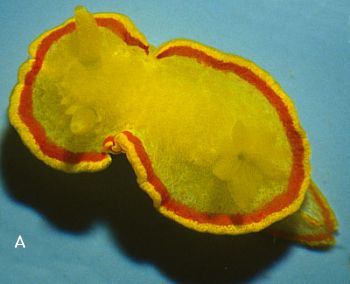
Diaphorodoris mitsuii
(Baba, 1938)
Order: NUDIBRANCHIA
Suborder: DORIDINA
Superfamily: ANADORIDOIDEA
Family: Onchidorididae
DISTRIBUTION
Japan and Hong Kong.
PHOTO
PHOTO: A. Hong Kong, April 1983, AM C139205. B. Ping Chau (S), Mirs Bay, 4-10 m. 20 April 1983, AM C139187. C. showing prominent median ridge on posterior foot. Hong Kong, April 1983, AM C139205. D. 5 specimens, Round Is. (W), Mirs Bay, 3-6 m. 14 April 1983, AM C139186. PHOTOS: B.E. Picton.
The mantle is ovate with the posterior end of the foot extending behind the end of the mantle. A distinctive feature is the distinct middorsal ridge on the posterior end of the foot. The mantle has small tubercles and the five or six gills are attached in a common pocket. Diaphorodoris mitsuii was originally recorded from southern Japan but the few specimens reported from there have been bright yellow with a submarginal orange-red band on the mantle and the foot. The gills and rhinophores are yellow. A few specimens with this yellow colour form have been found in Hong Kong but the most common form has a white body with the submarginal orange-red band and a bright yellow band at the edge of both the mantle and the foot. The gills and rhinophores are white.
One white specimen also has a yellow line, bordered with red, on the median ridge of the foot and the rhinophore lamellae are red. These all appear to be colour varieties of the one species. This species grows to about 8 mm long and most probably feeds on encrusting colonial bryozoans.
-
Rudman, W.B. & Darvell, B.W. (1990) Opisthobranch molluscs of Hong Kong. Part 1. Goniodorididae, Onchidorididae, Triophidae, Gymnodorididae, Chromodorididae, (Nudibranchia). Asian Marine Biology, 7: 31-79
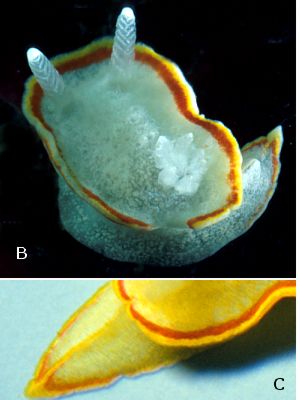
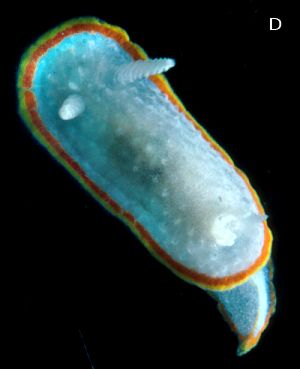
Rudman, W.B., 2001 (July 5) Diaphorodoris mitsuii (Baba, 1938). [In] Sea Slug Forum. Australian Museum, Sydney. Available from http://www.seaslugforum.net/find/diapmits
Related messages
Diaphorodoris from the Red Sea
March 27, 2009
From: Binyamin Koretz
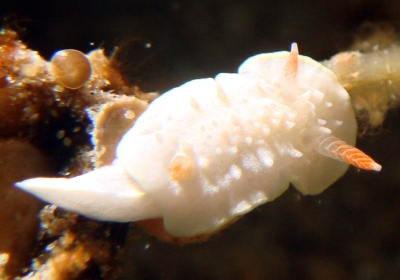
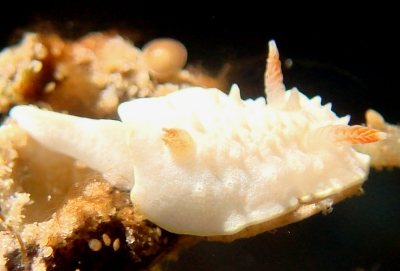
Concerning message #22087:
Dear Bill,
Came across this very small chromodorid and thought maybe it could be a juvenile Diversidoris aurantionodulosa based on the orange color on the rhinophores and gills, the yellow coloring at the margin of the mantle, and of course the tubercles on the notum. I wasn't able to measure its length and my impression in situ was around 3 mm when it was curled around the little 'stick', but based on how big the photos came out when it was stretched out I'm revising that guess to about 5 mm or so.
Locality: Eilat, Tables South, 28 m, Israel, Red Sea (Gulf of Eilat), 20 March 2009, sea grass. Length: 5 mm (est.). Photographer: Binyamin Koretz.
What do you think?
Best regards
Binyamin
binyamin@koretz.net
Koretz, B., 2009 (Mar 27) Diaphorodoris from the Red Sea. [Message in] Sea Slug Forum. Australian Museum, Sydney. Available from http://www.seaslugforum.net/find/22353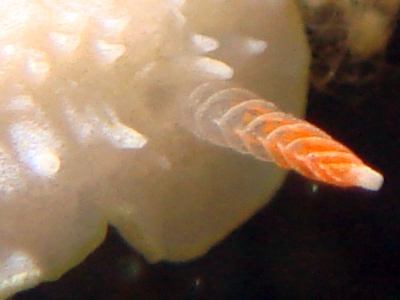
Dear Binyamin,
Although it looks quite like Diversidoris aurantionodulosa, the body looks more rigid than in most chromodorids. More importantly, the structure of the rhinophores is quite different. In the close-up you can see the lamellae slope down to form a V on the posterior side and are cup shaped, which is quite different from the closely layered lamellae found in most chromodorids. I am pretty sure this is the same as the animal in two earlier messages [#17545; #21713 ] which I am sure are a species of Diaphorodoris. I have tentatively placed them with D. mitsuii but the reddish band on the rhinophores is not present in that species. I guess we will have to wait until we get more records from the Indian Ocean. The western Pacific animals show quite a bit of colour variability so perhaps there is a similar amount of variability - if slightly different colours - in the Indian Ocean population.
One other possible clue is that species of Diaphorodoris feed on bryozoans and I suspect the 'stick' your animal is on is a bryozoan colony.
Best wishes,
Bill Rudman
Re: Diaphorodoris mitsuii ? from Indonesia
July 18, 2008
From: Colin Ogden
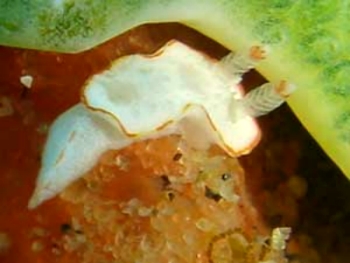
Concerning message #17545:
Hi Bill,
following the message from Francis and Pirjo, I thought you might be interested that we have the same Diaphorodoris here, and I have also been misidentifying it as a D. mitsuii. It is reasonably common here.
Locality: Sodwana Bay, 14 metres, South Africa, Indian, 24 APR 2007, reef. Length: 6 mm
Regards
Colin
scubaco@iafrica.com
Ogden C. M., 2008 (Jul 18) Re: Diaphorodoris mitsuii ? from Indonesia. [Message in] Sea Slug Forum. Australian Museum, Sydney. Available from http://www.seaslugforum.net/find/21713Thanks Colin,
I am just a bit hesitant to positively identify it as D. mitsuii because of the position of the orange band around the mantle edge. Terry Gosliner records this species in his Nudibranchs of Southern Africa but although noting its similarity to D. mitsuii is unsure because of his animal's white background and the ridge on its foot. We now know that D. mitsuii has both these characters but what we don't yet know is if it can have the red-orange band right at the mantle edge.
Best wishes,
Bill Rudman
Diaphorodoris mitsuii ? from Indonesia
July 15, 2008
From: Francis & Pirjo Pellet
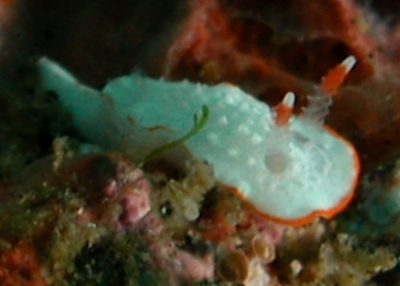
Concerning message #17499:
Dear Bill,
After seeing the shots off Diaphorodoris mitsuii on the Forum, we remember having a picture from Lembeh (Indonesia) looking very much the same : please can you tell us if this is another color form of the same species.
Locality: Indonesia, North Sulawesi, Lembeh-Strait, 14 m, Indonesia, North Sulawesi, 04 October 2005, Reef. Length: 5-7 mm. Photographer: Francis Pellet.
Thank you very much
Francis & Pirjo Pellet
pirjo.pellet@free.fr
Pellet, F. & P., 2008 (Jul 15) Diaphorodoris mitsuii ? from Indonesia. [Message in] Sea Slug Forum. Australian Museum, Sydney. Available from http://www.seaslugforum.net/find/17545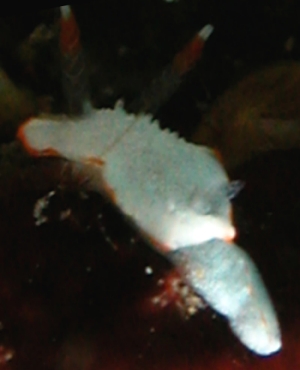
Dear Francis & Pirjo,
This is an interesting find. It is ceratinly a species of Diaphorodoris but I havent seen a specimen of D. mitsuii in which the red line is right at the edge of the mantle rather than submarginal. I guess we will have to wait until more specimens are found in the Indonesian region
Best wishes,
Bill Rudman
Diaphorodoris mitsuii from Tasmania, Australia
August 18, 2006
From: Bill Rudman
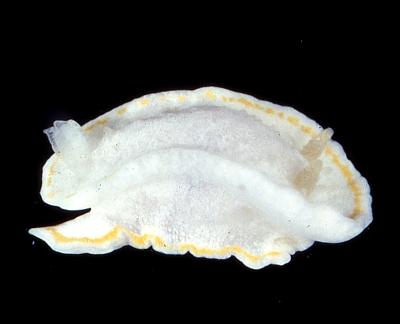
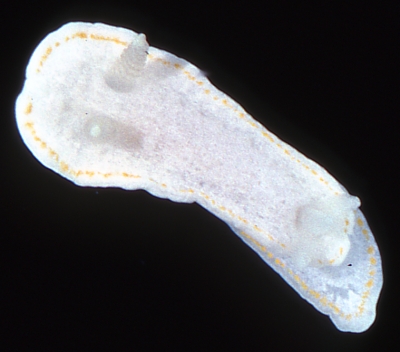
To accompany Leanne & David Atkinson's record of Diaphorodoris mitsuii from New South Wales, in eastern Australia [message #17465 ], here is a record from Tasmania
Locality: Cathedral Cove system, Eaglehawk Neck, SE Tasmania, SE Australia. 13 April 1993. 21 m. Collected by: G Close. Photos Bill Rudman AM C173821, 2 specimens, Size - very small approx 5-7 mm long.
As with the Atkinson's animals, the colour pattern, with a submarginal yellow border is not the common NW Pacific colour form. This species is possibly an introduction to SE Australia, but without further information it is hard to be sure.
Best wishes
Bill Rudman
Diaphorodoris mitsuii from New South Wales, Australia
August 18, 2006
From: Leanne & David Atkinson
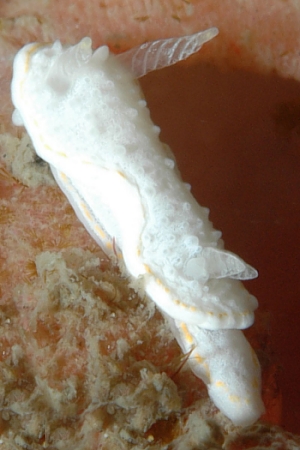
Dear Bill,
We came across this tiny nudibranch at the weekend and haven't been able to find it in any of our books. The characteristic that stuck us the most was the spiral shape of the rhinophores. We did a search on the forum for that phrase and didn't get any hits. The other characteristic that stood out was the lumpy appearance of the mantle. Sorry the shots don't show the gills well. It was on the move in a silty environment, across the mouth of an ascidian that contracted at one stage when I brushed it with the camera housing. 1:1 gives very poor depth of field. Can you please identify it for us?
Locality: The Pipeline, Port Stephens, 7 metres, NSW, Australia, Pacific Ocean, 12 August 2006, Sandy, silty bottom covered in sponges soft corals ascidians and bryozoans. Length: 5mm. Photographer: Leanne & David Atkinson.
Thanks for your help,
Leanne & David Atkinson
atk@hunterlink.net.au
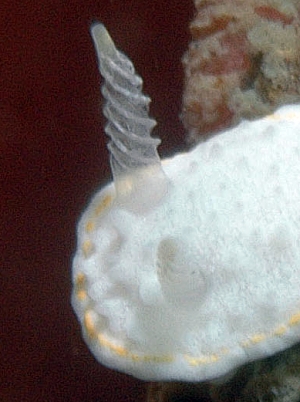
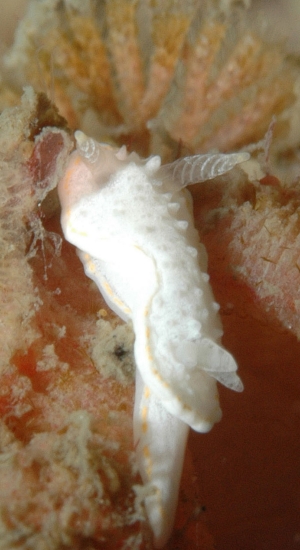
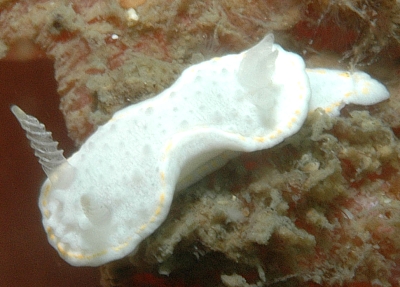
Dear Leanne & David,
This is a nice find. It is a colour form of Diaphorodoris mitsuii. The rhinophores do seem to have spiral ridges on them but if you look at the photos I posted yesterday from Korea [message #17416] you will see the ridges or leaflets, are arranged symmetrically on each side of the rhinophore, and don't form a spiral. It is quite a coincidence that your message should arrive just as I was posting Dong Bum Koh's message from the Yellow Sea. You will notice that your animal only has a submarginal yellow band around the mantle and the foot, while in most specimens from Japan and Sth Korea there is a yellow marginal and red submarginal band. However Japanese specimens are sometimes reported to have just a yellow submarginal band
This species has not been reported outside the NW Pacific before. I have also a couple of records of it from Tasmania which I am posting in a separate message [#17499 ]. In both cases the specimens were very small and I have been waiting for more specimens to be found down here. Interestingly they are the same colour form as your animals.
Best wishes,
Bill Rudman
Diaphorodoris mitsuii from the Yellow Sea
August 17, 2006
From: Dong Bum Koh
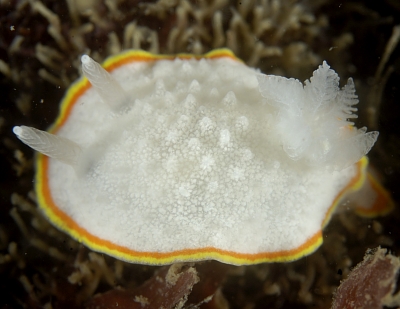
Dear Bill,
Last weekend our DEPC (Digital Eco-Photo Club) members visited the Yellow Sea.
We've got several photos from Tae An area.[126° E 36° 8'N] Here is some photos of Diaphorodoris mitsuii
Locality: Tae An area.[126° E 36° 8'N], -10m, South Korea, Yellow Sea, 5~6 August 2006. Photographer: Sung Soon Choi.
Best regards,
Dong Bum Koh
drkoh@seasee.co.kr
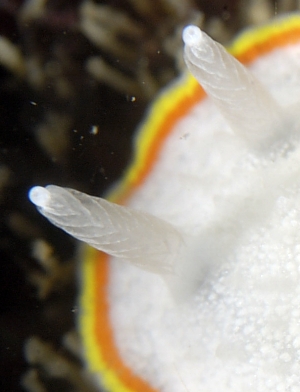
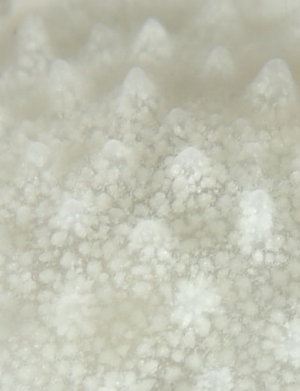
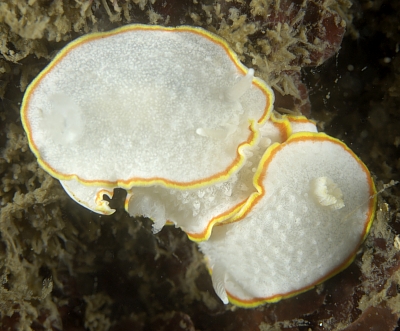
Dear Koh,
Thanks for these photos. In the photo alongside the lower two animals appear to be mating. I have included a couple of close-ups to show the rounded papillae which cover the mantle, and the granular nature of the skin.
Best wishes,
Bill Rudman
Parenthesis around author's name
January 17, 2006
From: Dong Bum Koh
Dear Bill,
Could you let me know why sometimes author and date are in parentheses and other times they are not.
for example :
Trapania toddi Rudman,1987
-- non-existence of parenthesis
Diaphorodoris mitsuii (Baba,1938)
-- existence of parenthesis
Best regards,
Dong Bum Koh
drkoh@seasee.co.kr
D.B.Koh, 2006 (Jan 17) Parenthesis around author's name. [Message in] Sea Slug Forum. Australian Museum, Sydney. Available from http://www.seaslugforum.net/find/15582Dear Koh,
We only put an author's name in parenthesis [= brackets, (...)] when the genus name is no longer the one the author originally used. In your example Diaphorodoris mitsuii (Baba,1938) was originally named Lamellidoris mitsuii and until Sandra Millen in 1985 moved it to the genus Diaphorodoris it was known as Lamellidoris mitsuii Baba, 1938.
Best wishes,
Bill Rudman
Diaphorodoris mitsuii from South Korea
August 23, 2005
From: Dong Bum Koh
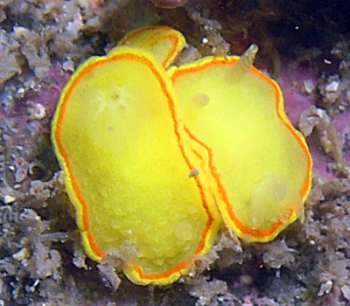
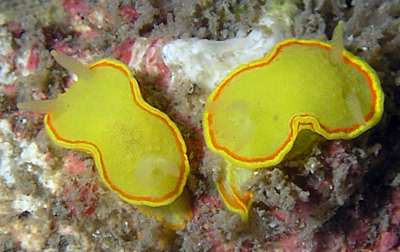
Dear Bill,
Here are some photos what I think of Diaphorodoris mitsuii (Baba, 1938)from Sth Korea.
This animal was taken by my friend at Bum islet, at that time he observed 5~6 guys in small area.
Locality: Bum islet. Seogwipo. Jeju, South Korea. Depth: 15 m. Length: Approx.10 mm. 12 Aug. 2005. Stony. Photographer: Sung Han Cho
I'm not sure although attached 2 animals look like mating?
Dong Bum Koh
drkoh@seasee.co.kr
Koh, D.B., 2005 (Aug 23) Diaphorodoris mitsuii from South Korea. [Message in] Sea Slug Forum. Australian Museum, Sydney. Available from http://www.seaslugforum.net/find/14602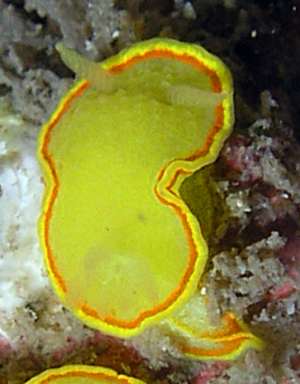
Dear Koh,
Yes this is Diaphorodoris mitsuii. In the photo alongside the median ridge on the posterior part of the foot is very easy to see. Although they certainly look 'friendly' the two animals have their left sides together so they can't be mating.
Best wishes,
Bill Rudman
White form of Diaphorodoris mitsuii from Japan
August 31, 2001
From: Nishina Masayoshi
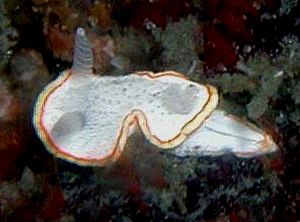
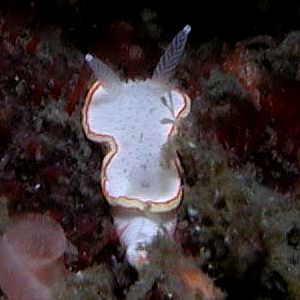
Dear Dr.Rudman,
Here is another Diaphorodoris mitsuii. Chikako photographed it at the original place where His Majesty the Emperor collected sea slugs for the book Opisthobranchs of Sagami Bay.
Shibasaki Hayama, Japan
Depth: 8m
Size: 5mm
Comment: uncommon here
Photo by Nishina Chikako.
Best Regards,
Nishina Masayoshi
nishina@hpe15.wips.co.jp
Nishina, M., 2001 (Aug 31) White form of Diaphorodoris mitsuii from Japan. [Message in] Sea Slug Forum. Australian Museum, Sydney. Available from http://www.seaslugforum.net/find/5018Thanks Nishina,
Bill Rudman
Diaphorodoris mitsuii from Hong Kong
August 5, 2001
From: Bill Rudman & Brian Darvell

Here is some information and photos on Diaphorodoris mitsuii from Brian Darvell's Hong Kong collections.
The mantle is ovate with the posterior end of the foot extending behind the end of the mantle. A distinctive feature is the distinct middorsal ridge on the posterior end of the foot. The mantle has small tubercles and the five or six gills are attached in a common pocket. Diaphorodoris mitsuii was originally recorded from southern Japan but the few specimens reported from there have been bright yellow with a submarginal orange-red band on the mantle and the foot. The gills and rhinophores are yellow. A few specimens with this yellow colour form have been found in Hong Kong but the most common form has a white body with the submarginal orange-red band and a bright yellow band at the edge of both the mantle and the foot. The gills and rhinophores are white. One white specimen also has a yellow line, bordered with red, on the median ridge of the foot and the rhinophore lamellae are red. These all appear to be colour varieties of the one species. This species grows to about 8 mm long and most probably feeds on encrusting colonial bryozoans.
PHOTO: A. Hong Kong, April 1983, AM C139205. B. Ping Chau (S), Mirs Bay, 4-10 m. 20 April 1983, AM C139187. C. showing prominent median ridge on posterior foot. Hong Kong, April 1983, AM C139205. D. 5 specimens, Round Is. (W), Mirs Bay, 3-6 m. 14 April 1983, AM C139186. PHOTOS: B.E. Picton.
Hong Kong Collection Records: AM C139186, 5 specimens, 14 April 1983, Site 2.66, Round Is. (W), Mirs Bay, 3-6 m. AM C139187, 20 April 1983, Site 3.80, Ping Chau (S), Mirs Bay, 4-10 m. AM C140172, 20 specimens, 24 July 1983, Site 11.87, South Ninepin (SE), 14 m. AM C140173, 31 July 1983, Site 4.23, Gau Tau (W), Mirs Bay, 17 m. AM C150292, 13 April 1986, Site 2.32, Round Is. (E), Mirs Bay, 9 m. AM C150293, 3 specimens, 18 April 1986, Site 4.59, Gau Tau (N), Mirs Bay, 17 m. AM C150294, 2 specimens, 19 April 1986, Site 2.127, Cock's Head Rock, Mirs Bay, 7 m. AM C150295, 15 April 1986, Site 3.80, Ping Chau (S), Mirs Bay, 1 m. AM C139205, 19 April 1983, Site 4.8, Breaker Reef, Mirs Bay, 5-16 m. AM C150300, 4 specimens, 13 April 1986, Site 2.32, Round Is. (E), Mirs Bay, 14 m. AM C 1 50301, 15 April 1986, Site 3.80, Ping Chau (S), Mirs Bay, 11 m. AM C149773, 16 March 1986, Site 11.87, South Ninepin (SE), 17 m. Depth range: 3-17 m.
Reference:
• Rudman, W.B. & Darvell, B.W. (1990) Opisthobranch molluscs of Hong Kong. Part 1. Goniodorididae, Onchidorididae, Triophidae, Gymnodorididae, Chromodorididae, (Nudibranchia). Asian Marine Biology, 7: 31-79
Best wishes,
Bill Rudman & Brian Darvell


Diaphorodoris mitsuii from Sagami Bay, Japan
August 5, 2001
From: Nishina Masayoshi
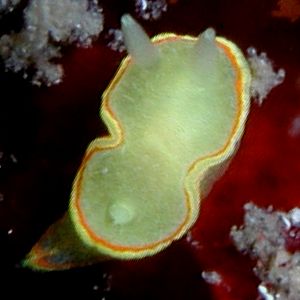
Dear Dr.Rudman,
Here is a photo of Diaphorodoris mitsuii that Chikako took on 7th July, 2001 at Enoura Beach, Sagami Bay, Japan.
Depth: 7m
Size: 5mm
Comment: Fairly common. There is white colour form of D. mitsuii as well.
Nishina Masayoshi
nishina@hpe15.wips.co.jp
Nishina, M., 2001 (Aug 5) Diaphorodoris mitsuii from Sagami Bay, Japan. [Message in] Sea Slug Forum. Australian Museum, Sydney. Available from http://www.seaslugforum.net/find/4973Dear Nishina,
Thanks for this photo of Japanese animals. I a separate message I have included some photos of the colour varieties found in Hong Kong.
Best wishes,
Bill Rudman.
